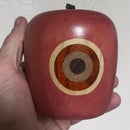Introduction: Micro Processor Chess Set
Rather than play the computer chess, why not make a chess set out of the computer!
This is version 0.1 (beta). If I can get enough Pentium "586" chips, I'd like to make a regulation size chess set.
Any constructive criticism would be appreciated!
This is version 0.1 (beta). If I can get enough Pentium "586" chips, I'd like to make a regulation size chess set.
Any constructive criticism would be appreciated!
Step 1: Chess Board
The board is the underside of a mother board, and 32 black microprocessor chips. This creates the colors Green vs Black. Each chip was attached with epoxy.
The principal hardware was left on the bottom side. Legs for elevation are bolts press-fitted into the chassis mount holes.
All subsequent pieces were painted green or black, if necessary, to indicate side.
The principal hardware was left on the bottom side. Legs for elevation are bolts press-fitted into the chassis mount holes.
All subsequent pieces were painted green or black, if necessary, to indicate side.
Step 2: Pawns
The pawns are made from capacitors found on most CPU power supplies, with a plastic figure base attached with epoxy.
These were the hardest to standardize- 16 of the same parts was hard. I salvaged through more than 12 power supplies to get the eight and eight matching parts.
These were the hardest to standardize- 16 of the same parts was hard. I salvaged through more than 12 power supplies to get the eight and eight matching parts.
Step 3: Rooks
The rooks are power transformers from CPU power supplies, with heat sinks cut to size for crenelations.
Step 4: Knights
I found some high-end power supplies that had nice relays encased in plastic. These made good bodies for the knights. The heads were fashioned from inductor coils, cut into a c-shape.
The top corner of the relay was cut off at 45 degrees, providing an attach-point for the inductor using epoxy. After attaching, the connection was improved by wrapping additional copper wire around the joint.
The top corner of the relay was cut off at 45 degrees, providing an attach-point for the inductor using epoxy. After attaching, the connection was improved by wrapping additional copper wire around the joint.
Step 5: Bishops
The bishops are the armatures from hard disk drives, with green or black wire wrapped around the base. The wire increased the base's cross section, improving epoxy attachment surface area.
Step 6: Queens
The Queens are (from base to top)-
1. Clock battery from mother boards,
2. RF choke filter ferrite core from data cable,
3. Electric motor core from pen-plotter motors,
and crown made of-
4. Hard disk platter washer,
5. with 6 green/black (IR) LEDs for jewels.
1. Clock battery from mother boards,
2. RF choke filter ferrite core from data cable,
3. Electric motor core from pen-plotter motors,
and crown made of-
4. Hard disk platter washer,
5. with 6 green/black (IR) LEDs for jewels.
Step 7: Kings
The kings bodies are made from motor cores of two paper shredders.
The crowns are hard drive washers, topped with the armature from old Zip drives- creating the holy seal.
The crowns are hard drive washers, topped with the armature from old Zip drives- creating the holy seal.





